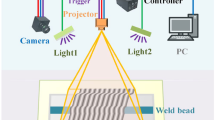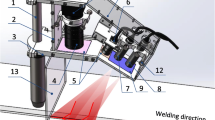Abstract
In manual welding, an experienced welder acquires 80% of the welding process information by vision. Visual sensing has the advantage of supplying abundant information without contact with the workpiece or welding circuit. Visual sensors have been widely used in the field of welding. According to optical imaging principles, the object imaging process depends on the shape, size, position, and angle of the light source; the shape of the object; the reflectance characteristic of the object’s surface; and the position, angle, and inner parameters of the camera. In order better to utilize the image information of a visual sensor and to ascertain the weld shape and size, arc light intensity is calculated from the arc length and the welding current. The visual sensing system is analyzed from the point of the view of light intensity. The function of adjusting the system to the light intensity is formulated in this paper. A relationship between the gray image, arc length, and welding current can be obtained. Welding experiments were implemented. Thus, we can recover the shape and height of the weld pool by SFS (shape from shading) algorithms from the weld pool image.
Similar content being viewed by others
References
Wu L, Chen S (2000) Intelligent welding technology. National Defence Industry Press, Beijing
Shi Y et al. (1999) Application of vision and image processing technology in welding engineering. Electr Welding Mach 29(9):1–4
Song Y et al. (1992) Spectrum sensing technology of arc image information. Trans Welding Inst 13(2):127–132
Zhao D (2000) Dynamic intelligent control for weld pool shape during pulsed GTAW with wire filler based on three-dimension visual sensing. Disseration, Harbin Institute of Technology
Yang C, Lin S (1998) A study of arc length control with arc light sensor in TIG welding, Mater Sci Technol 6(1):50–53
Wang Q (2000) Real-time sensing and control of arc welding process quality. Machine Press, Beijing
Lee JH, Na SJ (2001) An analysis of volumetric radiation heat flux and experimental comparison with arc light sensing in GTA welding process. J Mater Process Technol 110:104–110
Liu J (2002) Using arc light to detect and control tungsten. J Shanghai College Electricity Mach Technol 47(3):1–3
Lou Y et al. (1997) Simultaneous image sensing of front and backside weld pool in a frame of pulsed TIG welding. Robot 19:59–63
He Y (1993) Interference filter and measure. Measure Technol (10):19–22
Li P (1993) An applied basic research for arc light sensing in arc welding process. Dissertation, Harbin Institute of Technology
Author information
Authors and Affiliations
Corresponding author
Rights and permissions
About this article
Cite this article
Laiping, L., Tao, L. & Shanben, C. Light intensity analysis of a passive visual sensing system in GTAW. Int J Adv Manuf Technol 27, 106–111 (2005). https://doi.org/10.1007/s00170-004-2149-9
Received:
Accepted:
Published:
Issue Date:
DOI: https://doi.org/10.1007/s00170-004-2149-9




